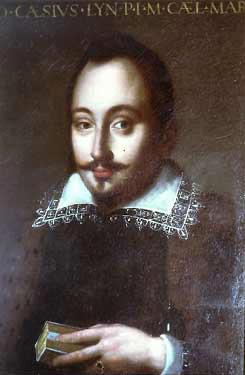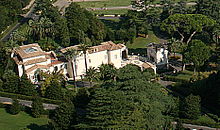The Accademia dei Lincei, anglicised as the Lincean Academy, is one of the oldest and most prestigious European scientific institutions, located at the Palazzo Corsini on the Via della Lungara in Rome, Italy. Founded in the Papal States in 1603 by Federico Cesi, the academy was named after the lynx, an animal whose sharp vision symbolizes the observational prowess that science requires. Galileo Galilei was the intellectual centre of the academy and adopted "Galileo Galilei Linceo" as his signature. "The Lincei did not long survive the death in 1630 of Cesi, its founder and patron", and "disappeared in 1651."
A pontifical academy is an academic honorary society established by or under the direction of the Holy See. Some were in existence well before they were accepted as "Pontifical."
The Pontifical Commission Ecclesia Dei was a commission of the Catholic Church established by Pope John Paul II's motu proprioEcclesia Dei of 2 July 1988 for the care of those former followers of Archbishop Marcel Lefebvre who broke with him as a result of his consecration of four priests of his Society of St. Pius X as bishops on 30 June 1988, an act that the Holy See deemed illicit and a schismatic act. It was also tasked with trying to return to full communion with the Holy See those traditionalist Catholics who are in a state of separation, of whom the Society of Saint Pius X (SSPX) is foremost, and of helping to satisfy just aspirations of people unconnected with these groups who want to keep alive the pre-1970 Roman Rite liturgy.
Roman academies refers to associations of learned individuals and not institutes for instruction.

The Pontifical Academy of Social Sciences is a pontifical academy established on 1 January 1994 by Pope John Paul II and is headquartered in the Casina Pio IV in Vatican City. It operates much like other learned societies worldwide, but has the special task of entering into dialogue with the Church. Its scientific activities are organised and focused to promote this dialogue.

The Casina Pio IV is a patrician villa in Vatican City which is now home to the Pontifical Academy of Sciences, the Pontifical Academy of Social Sciences and the Pontifical Academy of St. Thomas Aquinas. The predecessor of the present complex structure was begun in the spring of 1558 by Pope Paul IV in the Vatican Gardens, west of the Cortile del Belvedere. Paul IV commissioned the initial project of the 'Casina del Boschetto', as it was originally called, from an unknown architect; the first mention of the single-storey building can be found on 30 April 1558, and a notice of the following 6 May, says that the Pope spent "two thirds of his time at the Belvedere, where he has begun to build a fountain in the woods".

Federico Angelo Cesi was an Italian scientist, naturalist, and founder of the Accademia dei Lincei. On his father's death in 1630, he became briefly lord of Acquasparta.

Marcelo Sánchez Sorondo is an Argentine prelate of the Catholic Church who was Chancellor of the Pontifical Academy of Sciences and the Pontifical Academy of Social Sciences from 1998 to 2022. He was made a bishop in 2001. Having authored many publications in the sciences, he received several honors, including the Légion d’Honneur of France in 2000.

The Pontifical Academy of Saint Thomas Aquinas is a pontifical academy established on 15 October 1879 by Pope Leo XIII. The academy is one of the pontifical academies housed along with the academies of science at Casina Pio IV in Vatican City, Rome.
Giovanni Faber was a German papal doctor, botanist and art collector, originally from Bamberg in Bavaria, who lived in Rome from 1598. He was curator of the Vatican botanical garden, a member and the secretary of the Accademia dei Lincei. He acted throughout his career as a political broker between Maximilian I, Elector of Bavaria and Rome. He was a friend of fellow Linceian Galileo Galilei and the German painters in Rome, Johann Rottenhammer and Adam Elsheimer. He has also been credited with inventing the name "microscope".

The theology of Pope Pius XII is reflected in his forty-one encyclicals, as well as speeches and nearly 1000 messages, during his almost 20-year pontificate. The encyclicals Mystici corporis and Mediator Dei advanced the understanding of membership and participation in the Catholic Church. The encyclical Divino afflante Spiritu began opening the door to historical-critical biblical studies. But his magisterium was far larger and is difficult to summarize. In numerous speeches Catholic teaching is related to various aspects of life, education, medicine, politics, war and peace, the life of saints, Mary, the mother of God, things eternal and temporal.

Social teachings of Pope Pius XII refers to encyclicals, apostolic constitutions and speeches by Pope Pius XII on non-theological issues involving medicine, science, education, social justice, family and sexuality, and occupations.

The Pontifical Academy of Fine Arts and Letters of the Virtuosi al Pantheon is one of the Pontifical Academies under the direction of the Holy See. The complete Italian name of the academy, Pontificia Insigne Accademia di Belle Arti e Letteratura dei Virtuosi al Pantheon, includes the adjective insigne (illustrious), often omitted in official English translations. The term Virtuosi al Pantheon is also usually left untranslated, but, in any event, should not be taken in the English musical sense of “virtuoso” but rather “artists of great merit”. The Pantheon in Rome was the historical home of the academy. The term “academy” is meant in the Italian Renaissance definition of the term as an association of learned persons and not an institution of instruction.
The Pontifical Academy of Archaeology is an academic honorary society established in Rome by the Catholic Church for the advancement of Christian archaeological study. It is one of the ten such Pontifical Academies established by the Holy See.

The relationship between science and the Catholic Church has been both collaborative and contentious throughout history. Historically, the Catholic Church has served as a major patron of the sciences, playing an influential role in the establishment and funding of educational institutions, universities, and hospitals. Many members of the clergy have actively contributed to scientific research. Some historians of science, such as Pierre Duhem, attribute the origins of modern science to medieval Catholic scholars like John Buridan, Nicole Oresme, and Roger Bacon. However, the relationship has not been without conflict. Critics, including proponents of the conflict thesis, point to historical and contemporary tensions between the Church and science, such as the trial of Galileo, as examples of where the Church has opposed scientific findings that challenged its teachings. The Catholic Church, for its part, maintains that science and faith are complementary, as expressed in the Catechism of the Catholic Church, which addresses this relationship.
The Pontifical Academy of the Immaculate Conception or Pontifical Academy of (Mary) Immaculate, Italian: Pontificia Accademia dell'Immacolata, was an academic honorary society established in Rome by the Catholic Church for the advancement of the Marian dogma of Immaculate Conception.
The Pontifical Academy of Theology is a learned society founded in 1718, and is a Pontifical Academy. It is situated at Via della Conciliazione, Vatican City, Rome.
Accademia often refers to:
Science and the Popes is a part of the broader subject of science and the Catholic Church. Science and the popes have had a long yet sometimes rocky relationship throughout the history of the Catholic Church, with some popes condemning scientific books and findings, and other popes lauding scientists and the scientific fields. As the church believes the pope is the vicar of Christ, Catholics respect the pope's non-infallible personal opinions on non-theological subjects such as science. While there are ancient patron saints of medical topics, such as Saint Pantaleon, who was invoked during the Black Death, it is not known which pope canonized them.














